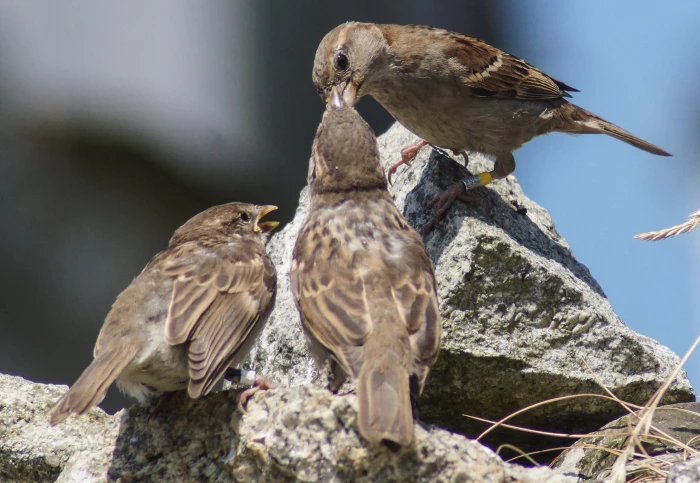Being friendly but not too friendly helps sparrows breed successfully


A new study shows that sparrows with more opposite-sex friends contribute more to the gene pool, but ‘average’ friendliness wins out in the long term.
Scientists have assumed for a long time that traits associated with how social an animal is – such as shyness or extraversion – have a genetic basis. This means some traits should be ‘selected for’ – they should be passed down by animals that are more successful at breeding as a result of their sociality.
We find that birds with an average amount of ‘friends’ have better fitness than those at the extremes. Jamie Dunning
But this has been difficult to test in the real world. Now, a team led by Imperial College London researchers have conducted a huge genetic study using the sparrow population of the island of Lundy.
The study, published today in Behavioural Ecology, shows sparrows that have more opposite-sex friends outside the breeding season are more successful at passing on their genes during the subsequent breeding season.
However, the 20-year study also shows that in the long term, sparrows with a ‘normal’ sociality – those that are neither extremely shy nor extremely friendly – have an advantage over those at the extremes for breeding success.
Average amount of friends
Lead author Jamie Dunning, from the Department of Life Sciences (Silwood Park) at Imperial, said: “Our research confirms that when you look at what happens over one year, birds with more connections to the other sex have higher breeding success.
“However, the social context a bird finds itself in changes over its lifetime. We find that birds with an average amount of ‘friends’ have better fitness than those at the extremes. This suggests that sociality is an evolutionarily stable trait.”
Lundy Island, in the Bristol Channel, hosts a ‘closed’ population of sparrows, meaning that no individuals leave or arrive on the island. This enabled the researchers to test the genetics of every sparrow and find out their lineage, building family trees for the whole population.
This allowed the team to determine the ‘fitness’ of each sparrow. Fitness is a measure of success in passing on genetic information, and in this study was quantified in two ways. The first is ‘recruits’ – how many of a sparrow’s chicks go on to mate and produce chicks of their own.
The second is ‘de-lifing’ – measuring the impact on the population growth if individual sparrows, and their subsequent generations of offspring, were removed. This retrospective look at a sparrow’s impact is only possible in such long and detailed studies.
Arriving at the (food) bar
Determining the sociality of individual sparrows was a trickier prospect. Previous studies on great tits have tracked how individuals group together at a feeding area. Sparrows, however, are more gregarious, and spend time at feeding stations in large, indistinct groups.
Instead, the team used data from the sparrows’ PIT (passive integrated transponder) tags, part of an RFID (radio-frequency identification) system, to determine when individuals arrived at the feeder after being in close proximity to each other, for example flying in from a nearby fencepost.
Jamie explained: “It’s like being at a bar. When waiting at the bar for a drink, you are surrounded by lots of people who may not be your friends. But you would have arrived at the premises with your friends – and that’s what we’re interested in.”
This showed that sparrows with more opposite-sex friends outside the breeding season had higher fitness in that year. This was the only measure of sociality however that had a positive impact on breeding success.
Over the lifetimes of sparrows in the experiment, average sociality, including opposite-sex friend numbers, had the most fitness benefit. This suggests that the benefit of more opposite-sex friends may be short-lived or dependent on the current situation – some years it may be more favourable than others.
The benefits of sociality may also change over each sparrow’s lifetime, for example fidelity to a partner over many years.
Jamie said: “Ideas about how sociality is selected for in a population have been around for a long time, but have proved difficult to test in a natural setting. Here we have an example from a wild population that shows how sociality can appear to be selected for in the short-term, but that over a lifetime, average sociality is best.”
-
‘Opposite-sex associations are linked with annual fitness, but sociality is stable over lifetime’ by Jamie Dunning, Terry Burke, Alex Hoi Hang Chan, Heung Ying Janet Chik, Tim Evans, and Julia Schroeder is published in Behavioural Ecology.
Supporters
Article text (excluding photos or graphics) © Imperial College London.
Photos and graphics subject to third party copyright used with permission or © Imperial College London.